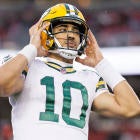Throughout this offseason, most of the attention paid to the New York Giants has surrounded the team's offense. Of course, it makes sense that things have focused there.
Since the end of their 2018 campaign, the Giants have seen last year's No. 2 overall pick, Saquon Barkley, win Offensive Rookie of the Year. They have seen Odell Beckham Jr. get shipped off to the Cleveland Browns via trade -- a deal in which they also acquired guard Kevin Zeitler. They have signed Golden Tate to fill (some of) Beckham's role in the offense.
They have picked up aging quarterback Eli Manning's roster bonus, thus ensuring he remains with the team for at least one more year. They have also drafted Manning's probable successor, Daniel Jones, using the No. 6 overall pick on the Duke QB (and being roundly criticized for doing so) before general manager Dave Gettleman stated that he could see Jones sitting behind Manning for as long as three seasons.
Of course, the near-exclusive focus on the offense has necessarily meant the Giants' defense has gone under-discussed. When looking at New York's depth chart on the less glamorous side of the ball, it's clear there is a general lack of talent. After trading Jason Pierre-Paul, Damon Harrison, and Olivier Vernon within the last two years, the Giants are thin up front -- and especially on the edge. The organization has rarely valued the linebacker position all that much, and even after trading for Alec Ogletree and drafting Lorenzo Carter and Oshane Ximines over the past two years, there's not much the Giants can definitively count on at the position.
New York is still solid at safety even after allowing Landon Collins to walk for a new contract with division rival Washington, having obtained Jabrill Peppers in the Beckham trade and followed it up by signing Antoine Bethea. But perhaps the most interesting area of the depth chart for the Giants is at cornerback.
Janoris Jenkins is likely locked in as the team's No. 1 corner on one side of the field. After that, the Giants have several talented options, but no clear idea of which players will distinguish themselves and fill the No. 2, slot, and dime cornerback roles. The Giants have actually invested a lot more in the position than people might realize.
Last offseason, they used a supplemental draft pick on former Western Michigan corner Sam Beal, who became the first player selected in a supplemental draft since 2015 after he recorded 92 tackles, two interceptions, and 19 passes defensed across his 32-game college career. Beal unfortunately suffered a shoulder injury during preseason and had to sit out his entire rookie year. The use of the supplemental pick on him robbed the Giants of their third-round pick in this year's draft, but they still used plenty of resources on corners once again.
The Giants' least-discussed first-round pick is DeAndre Baker, for whom they traded up to select with the No. 30 overall pick. Considered one of the top corners in the draft, he likely profiles as the Giants' future No. 1 when Jenkins' contract expires. Rookie cornerbacks do not necessarily always make an impact, but if he can step right into the lineup, that would be a nice development for New York's defense.
But Baker wasn't the only corner the Giants landed in this year's draft. They also scored Notre Dame's Julian Love in the fourth round and Washburn's Corey Ballentine in the sixth.
Ballentine has been the more discussed of the two players due to the tragic shooting death of his friend the night of the draft -- a shooting that also resulted in Ballentine suffering a thankfully non-life-threatening injury. Reports out of Giants camp are that he is looking the part of an NFL corner, which is an extremely encouraging sign for a sixth-round selection. Love, meanwhile, says he's been learning from getting beat by Golden Tate and Sterling Shepard in practices. Those lessons should prove valuable down the line.
But two young corners eventually developing into quality options does not necessarily help the Giants in 2019. It's becoming more and more clear that in the modern NFL, your back-end coverage and your pass rush are completely intertwined; and in more recent seasons the idea that coverage may actually be even more important than getting after the quarterback has become increasingly popular.
At this moment, the Giants' pass rush looks like it will not be impactful enough to make the quality of their coverage somewhat irrelevant. And unless they get quality performances from one or two of the three players who are essentially rookies, the opposite is true as well. That means New York may have to depend more on Grant Haley and/or Tony Lippett than would be ideal.
Haley's an undrafted free agent who appeared in 10 games as a rookie. He was decent enough when asked to contribute on special teams but allowed a 142.3 passer rating on throws in his direction, per Pro Football Focus. Opponents completed 25 of 33 passes for 297 yards and four scores, while recording zero interceptions and just two passes defensed. Granted, he was an undrafted rookie, but that does not exactly scream "this is a starting cornerback who we can count on." Lippett, meanwhile, is a converted wide receiver who was cut by the Dolphins. Again, not the most reliable option.
Maybe the rookies show up and none of this matters. But at this moment, this looks like perhaps the biggest question mark for a team that has gotten a lot of attention this offseason, with much of it focused elsewhere.

















